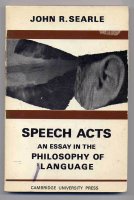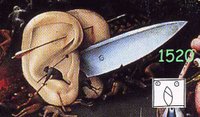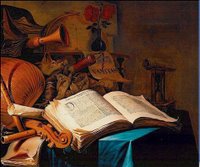
The art history library at UC Berkeley is like a
vanitas still life, with a clock visible through the window next to graduate students' shelves for books relating to projects they are trying to complete. The campanile is used for storing
fossils from the La Brea tar pits, and when there is a special lecture there are wine, bread, bottled water, and grapes or strawberries, and there are people with and without gray hair, and the uncomfortable chairs seen in the picture at the left. During a lecture, with the lights out in order to show slides, it is impossible to read the books, and the wine is usually not opened until after the lecture.
The Garden of Delights/El Jardín de las Delicias predates the typical
vanitas paintings of the seventeenth century, which makes it more difficult to see as an illustration of the book of
Ecclesiastes, but it is really simpler. The center panel has to do with enjoying life in the present since it is soon followed by death, shown in the right panel.

In the seventeenth century paintings the idea that "Of making many books there is no end: and much study is an affliction of the flesh" (Ecclesiastes 12:12) is expressed by painted books where the pages can never be turned, and in
The Garden of Delights/El Jardín de las Delicias there is practically no end to the books illustrated and the time it would take to explain all the allusions to books. The triptych's organization is reminiscent of hypertext as seen in libraries, systems for memory, concordances, and commentaries. The obscurity of the references to books serves a purpose, which is to remind the viewer that it would be better to do something like go outdoors and eat strawberries.

At the same time, the books illustrated in
The Garden of Delights/El Jardín de las Delicias have become obscure for various reasons, including the destruction of books in New Spain. The artist was so successful at conveying the idea of "nothing new under the sun" (Ecclesiastes 1:10) that the triptych has been regarded as the work of Hieronymus Bosch, who died before Europeans arrived on the mainland, which means that the attempt to convey that studying Nahuatl books was wearisome has not even been noticed. The detail is interesting since it seems to shed some light on the interactions between Europeans and Indians, as seen from the artist's perspective.
(see here later for a note on how the foregoing comments follow José de Sigüenza's chapter on the paintings in the Escorial)
























